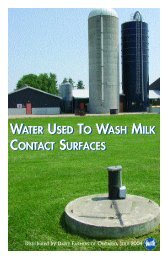Canadian Quality Milk On-Farm Food Safety Program - Centre ...
Canadian Quality Milk On-Farm Food Safety Program - Centre ...
Canadian Quality Milk On-Farm Food Safety Program - Centre ...
You also want an ePaper? Increase the reach of your titles
YUMPU automatically turns print PDFs into web optimized ePapers that Google loves.
<strong>Canadian</strong> <strong>Quality</strong> <strong>Milk</strong><br />
70% alcohol. Use a new swab or cotton ball for each teat. If you are treating all<br />
teats, scrub the teat ends on the far side of the udder first, and then scrub teats on<br />
the near side.<br />
Treat teats on the near side first, and then treat those on the far side.<br />
Use a mastitis treatment with a short infusion cannula or insert only the tip (3<br />
millimetres) of a long cannula. Be careful the cannula does not touch anything until<br />
it is inserted into the teat end.<br />
Slowly infuse antibiotic preparation into the quarter.<br />
Dip teats after treatment.<br />
4.4.3 Feeding Medicated Feed<br />
Producers that feed medicated feed must establish an SOP for feeding medicated feed.<br />
The same Best Management Practices that apply to livestock treatments, such as<br />
antibiotics, apply to medicated feeds. Medicated feeds must also be included on the<br />
List of Medicines and Chemicals Used for Livestock (Record 9).<br />
See Chapter 2 for more information on feeding medicated feed.<br />
4.5 IDENTIFICATION OF TREATED CATTLE<br />
Even when a treated animal's identification is recorded, it is essential in a valid HACCPbased<br />
on-farm food safety program to also mark animals in the milking herd that have<br />
been treated with animal health products that have a milk withdrawal. Proper marking<br />
ensures that milking personnel know which animals have been treated and when milk<br />
from each animal is safe to be placed in the bulk tank. This further reduces the chance<br />
of shipping an animal or its milk before the appropriate withdrawal period; thereby,<br />
reducing the risk that contaminated milk could become human food.<br />
Dry cows must be marked if they have been treated with a product that has a milk<br />
withdrawal and there is a risk that the dry cows can accidentally be mixed with or enter<br />
the milking herd. For example, if there is only a gate separating lactating and dry<br />
groups and the gate could accidentally be left open, treated dry cows must be marked.<br />
It is also unacceptable to have dry cows housed on the milking line in a tie stall barn<br />
without any indication that they are treated.<br />
Some methods for marking treated animals are:<br />
• Leg bands.<br />
• Coloured tape (surveyor's tape, hockey tape, duct tape) around legs or tail.<br />
• Paint or stock crayon markings on the animal's flank, rump, legs or udder.<br />
• In tie-stall barns, a marker placed on the milk or vacuum line in stalls occupied by<br />
treated animals plus the individual animals must be marked as being treated.<br />
• In free-stall barns, creating a separate treated group (no risk of mixing with non-<br />
June 2010 4—19
















